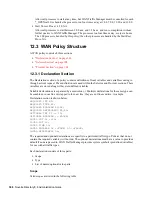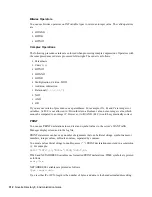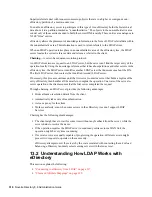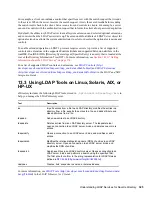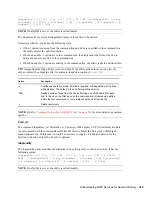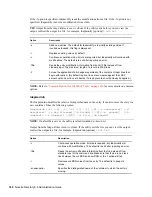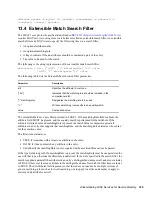
320
Novell eDirectory 8.8 Administration Guide
no
vd
ocx
(e
n)
6 Ap
ril 20
07
13.2.2 Class and Attribute Mappings
A
class
is a type of object in a directory, such as a user, server, or group. An attribute is a directory
element that defines additional information about a specific object. For example, a User object
attribute might be a user’s last name or phone number.
A
schema
is a set of rules that defines the classes and attributes allowed in a directory and the
structure of a directory (where the classes can be in relation to one another). Because the schemas of
the LDAP directory and the eDirectory directory are sometimes different, mapping LDAP classes
and attributes to the appropriate eDirectory objects and attributes might be necessary. These
mappings define the name conversion from the LDAP schema to the eDirectory schema.
LDAP Services for eDirectory provides default mappings. In many cases, the correspondence
between the LDAP classes and attributes and the eDirectory object types and properties is logical
and intuitive. However, depending on your implementation needs, you might want to reconfigure
the class and attribute mapping.
In most instances, the LDAP class to eDirectory object type mapping is a one-to-one relationship.
However, the LDAP schema supports alias names such as CN and commonName that refer to the
same attribute.
Mapping LDAP Group Attributes
The default LDAP Services for eDirectory configuration contains a predefined set of class and
attribute mappings. These mappings map a subset of LDAP attributes to a subset of eDirectory
attributes. If an attribute is not already mapped in the default configuration, an auto-generated map
is assigned to the attribute. Also, if the schema name is a valid LDAP name with no spaces or
colons, no mappings are required. You should examine the class and attribute mapping and
reconfigure as needed.
1
In Novell iManager, click the
Roles and Tasks
button
.
2
Click
LDAP
>
LDAP Overview
>
View LDAP Groups
.
3
Click an LDAP Group object, then click
Attribute Map
.
4
Add, delete, or modify the attributes you want.
Because there might be alternate names for certain LDAP attributes (such as CN and common
name), you might need to map more than one LDAP attribute to a corresponding eDirectory
attribute name. When LDAP Services for eDirectory returns LDAP attribute information, it
returns the value of the first matched attribute it locates in the list.
If you map multiple LDAP attributes to a single eDirectory attribute, you should reorder the list
to prioritize which attribute should take precedence because the order is significant.
5
Click
Apply
, then click
OK
.
Mapping LDAP Group Classes
When an LDAP client requests LDAP class information from the LDAP server, the server returns
the corresponding eDirectory class information. The default LDAP Services for eDirectory
configuration contains a predefined set of class and attribute mappings.
1
In Novell iManager, click the
Roles and Tasks
button
.
2
Click
LDAP
>
LDAP Overview
.
3
Click an LDAP Group object, then click
Class Map
.
Summary of Contents for EDIRECTORY 8.8 SP2
Page 4: ...novdocx en 6 April 2007...
Page 116: ...116 Novell eDirectory 8 8 Administration Guide novdocx en 6 April 2007...
Page 128: ...128 Novell eDirectory 8 8 Administration Guide novdocx en 6 April 2007...
Page 255: ...256 Novell eDirectory 8 8 Administration Guide novdocx en 6 April 2007...
Page 406: ...408 Novell eDirectory 8 8 Administration Guide novdocx en 6 April 2007...
Page 563: ...566 Novell eDirectory 8 8 Administration Guide novdocx en 6 April 2007...
Page 573: ...576 Novell eDirectory 8 8 Administration Guide novdocx en 6 April 2007...
Page 601: ...604 Novell eDirectory 8 8 Administration Guide novdocx en 6 April 2007...

